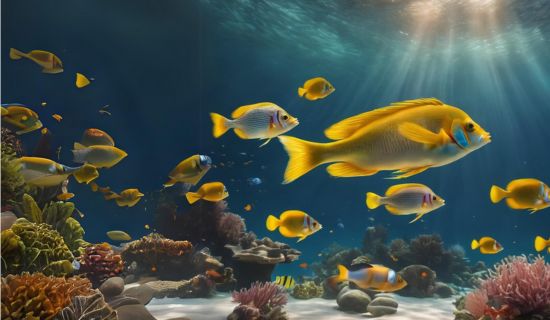Learn All about fish in video
I. Introduction
A. Definition and Importance
Fish as Aquatic Vertebrates
Fishes, as we know them, are remarkable aquatic vertebrates that have captured the curiosity of humans for centuries. These creatures are not only fascinating but also play a crucial role in our ecosystems. In this blog post, we will delve deep into the world of fishes, exploring their ecological and economic significance.

The Ecological Importance of Fishes
Fishes have an extraordinary impact on the environment, and understanding their ecological significance is essential for the preservation of aquatic ecosystems. Here are some key aspects to consider:
- Biodiversity and Conservation: The diversity of fish species is astonishing, and many are endangered. Conservation efforts are crucial to protect their unique qualities and maintain a balanced ecosystem.
- Aquatic Food Chains: Fishes often serve as both predator and prey, playing a pivotal role in various aquatic food chains. This delicate balance ensures the survival of many species.
- Cichlid Fishes: The incredible African cichlids are a prime example of ecological diversity, showcasing an array of colors and behaviors.
The Economic Significance of Fishes
Beyond their ecological importance, fishes also hold substantial economic value. Let’s explore the ways in which they contribute to our economy:
- Aquarium Industry: The ornamental fishes trade is a multi-million-dollar industry. Discover the world of aquarium fishes and their economic importance.
- Commercial Fishing: Commercial fishing provides a significant portion of the world’s seafood. Species like barramundi are highly sought after for their taste and nutritional value.
- Cultural Significance: Fish also have cultural importance, as seen in fish skin boots and fish and chips, which are a part of culinary traditions in many regions.
The Intriguing World of Fish Awaits
Intrigued by the diverse and vital world of fish? Whether you’re interested in the elegant betta fish or the mysterious blobfish, the more you learn about these aquatic creatures, the more you’ll appreciate their ecological and economic significance.
So, dive into this fascinating realm, explore the enchanting world of fish, and discover the myriad ways in which they impact our planet.
B. The Fascination with Fishes
Human Curiosity
From the majestic oceans to tranquil freshwater lakes, humans have always been drawn to the mysteries hidden beneath the water’s surface. Fishes, with their diverse forms and behaviors, have sparked our curiosity for generations.
Cultural and Artistic Interest
Fishes have also found their way into our cultural and artistic expressions. Their symbolism in various cultures and their presence in literature and art further underline their significance in the human experience.
II. Understanding Fish Species

A. Definition of a Fish
Characteristics
To understand fishes, we must first define them. Fishes are cold-blooded vertebrates with gills, finned limbs, and scales covering their bodies. These characteristics make them distinct from other aquatic creatures.
Distinguishing Features
Fish exhibit a wide range of features that differentiate them from one another, from body shape to coloration, each adaptation tailored to their unique environments.

B. The Diversity of Fish
Vast Species Count
The diversity of this creature species is staggering, with thousands of different types inhabiting our planet’s waters. We’ll explore the mind-boggling variety of fishes, from the tiniest minnows to the giant whales of the ocean.
Adaptations to Environments
Fish have adapted to thrive in a myriad of environments, whether it’s the frigid Arctic seas or the scorching hot springs. These adaptations are a testament to their resilience and evolutionary success.
C. Evolution of Fish

Early Fish Forms
The history of these creatures predates the age of dinosaurs. We’ll dive into the early fishes forms and explore how they laid the groundwork for the diversity we see today.
Evolutionary Milestones
From the first fish to walk on land to the development of jaws, fish have gone through several evolutionary milestones. These adaptations have paved the way for their survival in an ever-changing world.
III. Taxonomy and Classification
A. Kingdom: Animalia

Fish in the Animal Kingdom
Fishes find their place in the Animal Kingdom, sharing common traits with other creatures. We’ll take a closer look at what makes them unique within this vast kingdom.
Common Traits
From the simplest to the most complex, all animals, including fishes, share certain common traits. Understanding these traits helps us appreciate the evolutionary connections between species.
B. Phylum: Chordata

Chordates and Vertebrates
Fishes belongs to the Phylum Chordata, a group characterized by the presence of a notochord. We’ll explore how fishes fit within this phylum and distinguish themselves as vertebrates.
Fish in Chordata
Fishes, as chordates, exhibit a range of features that set them apart from other members of this phylum. These characteristics make them unique in the world of animals.
C. Class: Actinopterygii

Ray-Finned Fish
The class Actinopterygii is home to the ray-finned fishes, which constitute the majority of fish species. Their remarkable variability in size and shape is a testament to the wonders of evolution.
Remarkable Variability
From the tiny guppies in your aquarium to the massive marlins in the open ocean, ray-finned fishes showcase remarkable variability. We’ll explore how their diversity is a testament to nature’s creativity.
D. Order: Perciformes

Perciform Fish
Within the class Actinopterygii, we find the order Perciformes, a diverse group known for their striking appearances and unique behaviors. We’ll delve into the notable families that make up this order.
Notable Families
Perciformes encompass a wide range of fishes families, each with its own distinctive traits. We’ll examine some of the most prominent families and their contributions to the aquatic world.
E. Family: Cichlidae

Cichlid Family
The Cichlidae family is known for its stunningly colored and highly adaptable fish. We’ll explore the remarkable diversity and behaviors within this family.
Diversity Within
Cichlids have carved out a niche in a variety of environments, showcasing their adaptability and resilience. Their fascinating behaviors and unique breeding strategies make them a focus of study for researchers.

F. Genus and Species
Naming Conventions
The naming of fishes follows a systematic convention that aids in their identification and classification. We’ll uncover the intricacies of naming fish species and genera.
Specific Identification
Accurate identification of fish species is essential for conservation efforts and research. We’ll explore the methods and tools used to pinpoint the exact species.

G. Types of Fish Classification
Overview of Taxonomic Ranks
Understanding the different ranks within the taxonomy of fishes is crucial for comprehending their relationships and evolutionary history. We’ll provide an overview of these ranks.
Hybridization and Nomenclature
Hybridization, the interbreeding of different fishes species, can blur the lines of classification. We’ll discuss the challenges it poses and how nomenclature addresses these complexities.
IV. Anatomy and Physiology

A. External Features
Fins and Scales
Fishes exhibit a wide array of fins and scales, each serving a specific purpose in their survival. We’ll explore the functions of these external features in different species.
Specialized Appendages
Some fishes have evolved unique external appendages that help them navigate their environments. From anglerfish lures to flying fishes fins, these adaptations are truly fascinating.

B. Internal Structures
Organs and Systems
Beneath their sleek exteriors, fishes possess intricate internal organs and systems designed for specific purposes. We’ll dive into the anatomy that keeps these creatures alive and thriving.
Unique Adaptations
These creatures have developed some extraordinary internal adaptations, from air-breathing organs in lungfish to electrical organs in electric fish. These features highlight the versatility of fish physiology.

C. Fish Senses
Vision, Smell, and More
These creatures rely on a variety of senses to navigate their surroundings and locate prey. We’ll explore how their senses of vision, smell, and others have evolved for survival.
Sensory Evolution
The evolution of these creatures senses is a remarkable journey from primitive detection mechanisms to sophisticated sensory organs. We’ll trace this evolution and its implications for their behavior.

D. Unique Adaptations
Camouflage, Bioluminescence, and More
These creatures have developed numerous adaptations to avoid predators and secure prey. We’ll delve into fascinating tactics such as camouflage, bioluminescence, and more that aid in their survival.
Survival Strategies
These unique adaptations play a vital role in the survival of fish species. We’ll discuss how these strategies help them thrive in diverse environments.

V. Habitat and Distribution
A. Aquatic Ecosystems
Freshwater and Marine Habitats
Fish have made their homes in various aquatic ecosystems, including freshwater lakes, rivers, and vast marine environments. We’ll explore their roles in these habitats.
Role in Aquatic Ecosystems
Fish contribute significantly to the health of aquatic ecosystems by controlling populations and maintaining the balance of various species. Their presence is pivotal to the overall well-being of these ecosystems.

B. Freshwater vs. Saltwater Fish
Adaptations to Salinity
Fish have adapted differently to freshwater and saltwater environments. We’ll examine the distinct features and behaviors of these creatures in these two contrasting habitats.
Migration Patterns
Many fish species undertake impressive migrations across freshwater and saltwater environments. We’ll uncover the reasons behind these journeys and their importance in the life cycles of fishes.

C. Global Distribution
Fish Around the World
Fishes can be found in every corner of the globe, from the icy waters of the Arctic to the warm coral reefs of the tropics. We’ll take a worldwide tour to discover the most iconic species and unique adaptations in different regions.
Endemic Species
Some fish species are endemic to specific locations, making their conservation essential. We’ll highlight the significance of these endemic fishes and the threats they face.

Conclusion
In this comprehensive exploration of the world of fish, we’ve delved into the remarkable diversity of aquatic vertebrates. From their origins in Earth’s ancient oceans to their intricate adaptations and vital roles in various ecosystems, fishes have proven to be truly captivating creatures. Understanding their taxonomy, anatomy, and behaviors enriches our appreciation of these remarkable animals.
Stay tuned for the next part of this blog post where we’ll venture into the intriguing aspects of fishes diets and feeding habits, including their role in the ecosystem and their culinary significance.
FAQ
1. What is the oldest known fish species?
The oldest known fish species is the “Lamprey”. These jawless fish have a lineage dating back nearly 360 million years, making them one of the most ancient living vertebrates.
2. Do all fish have scales?
No, not all fishes have scales. While scales are a common feature among fishes, there are exceptions. For instance, catfish and some eels lack scales, relying on other forms of protection, such as slimy skin.
3. How do fish breathe underwater?
Fishes breathe underwater through gills. Gills are specialized respiratory organs that extract oxygen from the water as it flows over them. This adaptation allows fishes to extract dissolved oxygen from their aquatic environments, facilitating their survival underwater.
For further information on specific fish species, habitat details, and intriguing adaptations, you can explore the following URLs:



